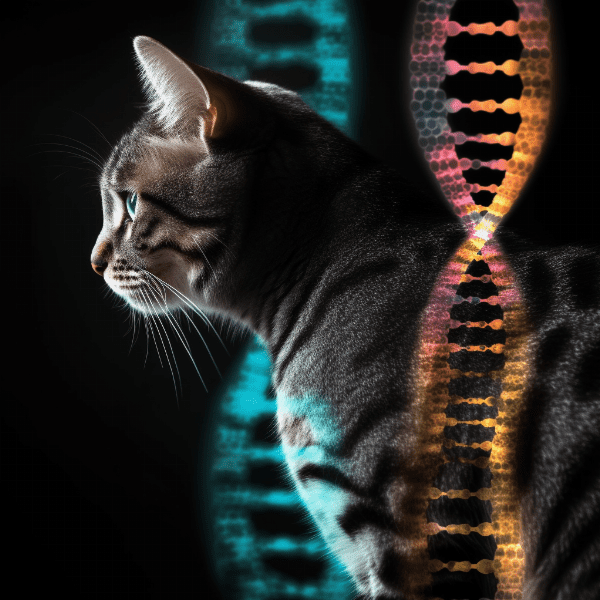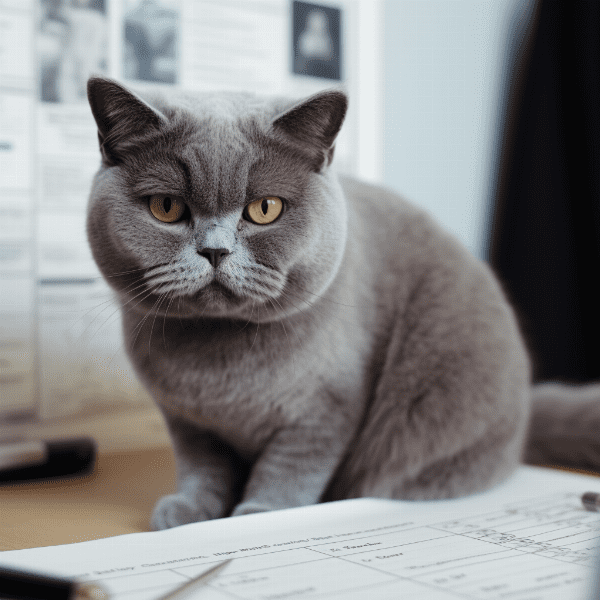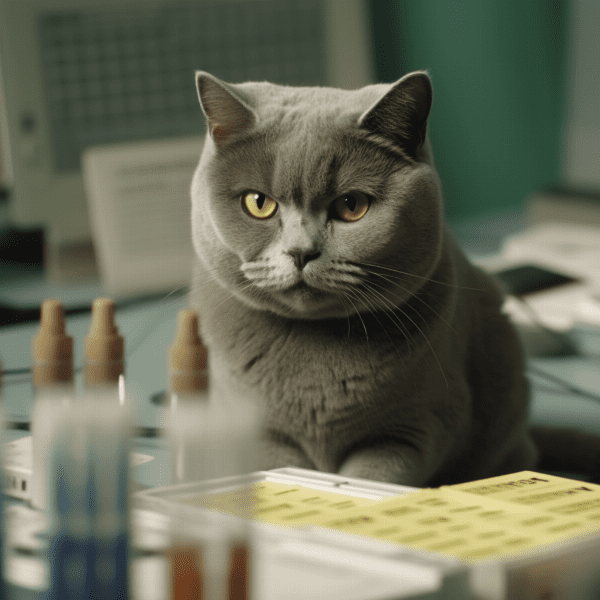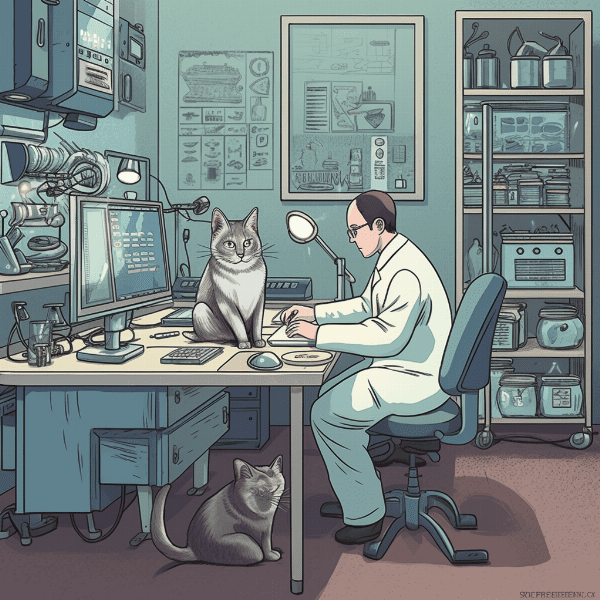Table of Contents
- Introduction to British Shorthair Cats
- Understanding Genetic Diseases
- Common Genetic Diseases in British Shorthair Cats
- Diagnosis and Treatment of Genetic Diseases
- Preventive Measures for British Shorthair Cats
- Breeding and Genetic Diseases
- Genetic Testing for British Shorthair Cats
- Ethical Considerations for Breeders and Owners
- Future Prospects for Preventing Genetic Diseases in British Shorthair Cats
Introduction to British Shorthair Cats
British Shorthair cats are one of the oldest and most popular cat breeds in the world. They are known for their plush, round features, and calm temperament. These cats are native to Great Britain, where they were originally used to control the rodent population in homes and shops. Today, they are one of the most sought-after breeds, loved for their loyal and affectionate personalities.
History and Origin
The British Shorthair cat is believed to have originated from cats brought to Great Britain by Roman soldiers over 2,000 years ago. The breed’s development continued over the centuries, with the introduction of new bloodlines and breeding programs. In the 19th century, the breed was officially recognized and became a popular show cat.
Physical Characteristics
British Shorthair cats have a distinctively round face, with chubby cheeks and large, expressive eyes. They have a muscular build, with short, dense fur that comes in a wide range of colors and patterns. These cats have a stocky, solid build and are typically medium to large in size.
Personality and Temperament
British Shorthair cats are known for their affectionate and calm personalities. They are easy-going and adapt well to different environments, making them great family pets. These cats are also independent and don’t require constant attention or playtime, making them a low-maintenance breed.
Popularity and Health Concerns
Due to their popularity, British Shorthair cats are often bred to meet demand, which can lead to health concerns such as genetic diseases. It’s important for breeders and owners to be aware of these health concerns and take preventative measures to ensure the health and wellbeing of their cats.

Understanding Genetic Diseases
Genetic diseases are disorders caused by abnormalities in an animal’s DNA. These disorders can be passed down from one generation to another through breeding. British Shorthair cats are prone to several genetic diseases due to their popularity and selective breeding practices. Understanding the basics of genetic diseases is important for breeders and owners to prevent and manage these conditions.
Genetics 101
Every living organism has DNA, which is made up of genes. Genes contain the instructions for the development and function of an organism. Inherited traits, such as coat color and eye color, are determined by genes. Genetic diseases occur when there is a mutation or change in one or more genes.
Modes of Inheritance
There are different modes of inheritance for genetic diseases, which affect the likelihood of a disease being passed down to offspring. The two most common modes of inheritance are:
- Autosomal recessive: The affected gene is located on an autosomal chromosome, and an animal must inherit two copies of the mutated gene (one from each parent) to develop the disease. In this mode of inheritance, carriers of the mutated gene do not show any symptoms, but can pass the gene on to their offspring.
- Autosomal dominant: The affected gene is located on an autosomal chromosome, and an animal only needs to inherit one copy of the mutated gene to develop the disease. In this mode of inheritance, affected animals will pass the mutated gene on to 50% of their offspring.
Identifying Genetic Diseases
Identifying genetic diseases in British Shorthair cats involves a combination of genetic testing, physical examinations, and medical history. Genetic testing can identify carriers of mutated genes, which can help breeders avoid mating carriers with each other. Physical examinations and medical history can help identify symptoms of a genetic disease and aid in diagnosis.

Common Genetic Diseases in British Shorthair Cats
British Shorthair cats are prone to several genetic diseases, many of which are inherited. These diseases can impact the health and wellbeing of these cats, and it’s important for breeders and owners to be aware of them to prevent and manage these conditions.
Hypertrophic Cardiomyopathy (HCM)
HCM is a genetic disease that affects the heart muscle, leading to thickening of the heart walls and decreased blood flow. This disease is inherited in an autosomal dominant manner and affects up to 13% of British Shorthair cats. Symptoms of HCM include difficulty breathing, coughing, and lethargy. Diagnosis of HCM involves a combination of physical examination, electrocardiography, and echocardiography.
Feline Lower Urinary Tract Disease (FLUTD)
FLUTD is a group of conditions that affect the urinary tract, including inflammation and blockages. This disease is not entirely genetic, but certain genetic factors may increase the risk of developing FLUTD. Symptoms of FLUTD include frequent urination, blood in the urine, and difficulty urinating. Diagnosis of FLUTD involves a combination of physical examination, urinalysis, and imaging.
Cystic Fibrosis (CF)
CF is a genetic disease that affects the respiratory and digestive systems, leading to chronic respiratory infections and digestive problems. This disease is inherited in an autosomal recessive manner and is relatively rare in British Shorthair cats. Symptoms of CF include coughing, difficulty breathing, and diarrhea. Diagnosis of CF involves a combination of genetic testing and medical history.
In the following sections, we will explore the diagnosis and treatment of genetic diseases in British Shorthair cats, and preventive measures that can be taken to maintain their health.

Diagnosis and Treatment of Genetic Diseases
Diagnosing and treating genetic diseases in British Shorthair cats can be challenging, but early detection and treatment can improve the cat’s quality of life. The diagnosis and treatment of genetic diseases involve a combination of genetic testing, physical examination, and medical history.
Physical Examination
Physical examination is an essential part of diagnosing and treating genetic diseases in British Shorthair cats. These exams can help identify symptoms of a genetic disease, such as enlarged kidneys or heart murmur. Early detection of symptoms can lead to early intervention and treatment.
Medical History
A thorough medical history can provide valuable information for diagnosing and treating genetic diseases in British Shorthair cats. This includes information about the cat’s diet, environment, and any previous medical conditions. A detailed medical history can help identify risk factors for certain genetic diseases and guide treatment decisions.
Treatment Options
Treatment options for genetic diseases in British Shorthair cats vary depending on the disease and severity of symptoms. In some cases, treatment may involve medication, surgery, or dietary changes. In other cases, the disease may be managed through regular monitoring and preventive care.
Importance of Early Intervention
Early intervention and treatment are critical for managing genetic diseases in British Shorthair cats. Regular veterinary checkups and genetic testing can help identify genetic diseases early on, allowing for prompt intervention and treatment. Early intervention can improve the cat’s quality of life and prevent the disease from progressing.
In the following sections, we will explore preventive measures that can be taken to maintain the health of British Shorthair cats and reduce the risk of genetic diseases.

Preventive Measures for British Shorthair Cats
Preventing genetic diseases in British Shorthair cats is a crucial part of maintaining their health and wellbeing. There are several preventive measures that breeders and owners can take to reduce the risk of genetic diseases.
Nutrition and Exercise
Proper nutrition and exercise can help prevent genetic diseases in British Shorthair cats. A balanced diet can improve the cat’s overall health and reduce the risk of obesity, which can lead to several health issues. Regular exercise can also improve the cat’s cardiovascular health and reduce the risk of certain genetic diseases.
Regular Veterinary Checkups
Regular veterinary checkups are essential for preventing genetic diseases in British Shorthair cats. These checkups can help identify genetic diseases early on, allowing for prompt intervention and treatment. Regular checkups can also detect other health issues that may impact the cat’s overall health.
Preventive Care
Preventive care, such as vaccinations and parasite prevention, can help maintain the health of British Shorthair cats and reduce the risk of certain genetic diseases. Vaccinations can prevent infectious diseases, while parasite prevention can reduce the risk of parasitic infections that can lead to health issues.
.

Breeding and Genetic Diseases
Breeding practices play a significant role in the development and spread of genetic diseases in British Shorthair cats. Breeders should be aware of the risk factors for genetic diseases and take steps to prevent the spread of these diseases.
Selective Breeding
Selective breeding practices can lead to a decrease in genetic diversity, which can increase the likelihood of genetic diseases. Breeders should aim to maintain genetic diversity in their breeding programs to prevent the spread of genetic diseases and improve the overall health of British Shorthair cats. This can be achieved by introducing new bloodlines and avoiding inbreeding.
Genetic Testing
Genetic testing is an important tool for breeders to identify carriers of mutated genes and prevent the spread of genetic diseases. Breeders should perform genetic testing on their breeding cats and avoid breeding cats with known genetic diseases. Genetic testing can also aid in the early detection of diseases, allowing for early intervention and treatment.
Health Screening
Health screening is an essential part of breeding British Shorthair cats. Breeders should perform regular health checks on their breeding cats, including physical examinations, blood tests, and genetic testing. Health screening can help identify carriers of genetic diseases and prevent the spread of these diseases.
Importance of Education
Education is an important tool for preventing the spread of genetic diseases in British Shorthair cats. Breeders should educate themselves and their clients about the risk factors for genetic diseases and the importance of preventive measures. Educating clients can also help prevent the spread of genetic diseases through responsible ownership practices.
.

Genetic Testing for British Shorthair Cats
Genetic testing is an important tool for preventing and managing genetic diseases in British Shorthair cats. These tests can identify carriers of mutated genes, which can help breeders avoid mating carriers with each other. Genetic testing can also aid in the early detection of diseases, allowing for early intervention and treatment.
- Carrier testing: This test identifies carriers of mutated genes. Carriers do not show any symptoms of the disease but can pass the mutated gene on to their offspring.
- Diagnostic testing: This test confirms the presence of a genetic disease in a cat showing symptoms.
- Predictive testing: This test predicts the likelihood of a cat developing a genetic disease based on their genetic makeup.
Benefits of Genetic Testing
Genetic testing can provide several benefits for British Shorthair cats, breeders, and owners. These include:
- Preventing the spread of genetic diseases: Genetic testing can identify carriers of mutated genes, allowing breeders to avoid mating carriers with each other and prevent the spread of genetic diseases.
- Early detection and treatment: Genetic testing can aid in the early detection of diseases, allowing for early intervention and treatment.
- Improved breeding practices: Genetic testing can improve breeding practices by identifying cats with desirable genetic traits and reducing the risk of inherited diseases.
- Peace of mind: Genetic testing can provide peace of mind for breeders and owners, knowing that their cats are not carriers of genetic diseases.
Considerations for Genetic Testing
There are several considerations to keep in mind when performing genetic testing on British Shorthair cats. These include:
- Accuracy of testing: Genetic testing is not always 100% accurate, and false positives or false negatives can occur. It’s important to use reputable laboratories and consult with veterinary professionals when interpreting test results.
- Cost of testing: Genetic testing can be expensive, and the cost can vary depending on the type of test and laboratory used. Breeders and owners should consider the cost of testing when making breeding and ownership decisions.
- Ethical considerations: Genetic testing should be performed in an ethical and responsible manner. Breeders and owners should prioritize the welfare of their cats and avoid practices that may harm their health.
In conclusion, genetic testing is an important tool for preventing and managing genetic diseases in British Shorthair cats. These tests can provide several benefits for breeders, owners, and cats, but there are also considerations to keep in mind when performing genetic testing. Veterinary professionals can provide guidance and support for breeders and owners regarding genetic testing for their cats.

Ethical Considerations for Breeders and Owners
Breeders and owners have an ethical responsibility to maintain the health and wellbeing of British Shorthair cats. This includes being transparent about genetic diseases and taking preventive measures to reduce the risk of inherited diseases.
Responsible Breeding Practices
Responsible breeding practices are essential for maintaining the health and wellbeing of British Shorthair cats. Breeders should aim to maintain genetic diversity in their breeding programs to prevent the spread of genetic diseases and improve the overall health of the cats. Breeders should also avoid breeding cats with known genetic diseases and perform regular health checks on their breeding cats.
Transparency and Education
Transparency and education are critical for maintaining the health and wellbeing of British Shorthair cats. Breeders and owners should be transparent about genetic diseases and take preventive measures to reduce the risk of inherited diseases. Educating clients can also help prevent the spread of genetic diseases through responsible ownership practices.
Ethical Considerations in Genetic Testing
Ethical considerations should be taken into account when performing genetic testing on British Shorthair cats. Genetic testing should be performed in an ethical and responsible manner, prioritizing the welfare of the cats. Breeders and owners should also consider the cost of testing and consult with veterinary professionals when interpreting test results.
Prioritizing Welfare
Breeders and owners have an ethical responsibility to prioritize the welfare of their cats. This includes providing proper nutrition and exercise, regular veterinary checkups, preventive care, and a safe and comfortable living environment. Breeders and owners should also avoid practices that may harm the health of their cats, such as inbreeding or breeding cats with known genetic diseases.
.

Future Prospects for Preventing Genetic Diseases in British Shorthair Cats
Advancements in genetic research and technology are opening up new possibilities for preventing and managing genetic diseases in British Shorthair cats. There are several future prospects for preventing genetic diseases in these cats.
Genetic Research
Advancements in genetic research are improving our understanding of the genetic basis of diseases in British Shorthair cats. Researchers are identifying new genetic mutations associated with various diseases, which can aid in the development of new diagnostic tests and treatments.
Gene Therapy
Gene therapy is a promising field that could provide a cure for genetic diseases in British Shorthair cats. This therapy involves introducing a healthy copy of the mutated gene into the cat’s cells, replacing the faulty gene and correcting the underlying genetic defect.
Genome Editing
Genome editing is another promising field that could provide a cure for genetic diseases in British Shorthair cats. This technology involves editing the DNA sequence of a cat’s genome, correcting the underlying genetic defect responsible for a disease.
Preventive Measures
Preventive measures, such as genetic testing and responsible breeding practices, will continue to play a crucial role in preventing genetic diseases in British Shorthair cats. As technology and research continue to advance, breeders and owners can make more informed decisions about breeding practices and genetic testing.
Collaborative Efforts
Collaborative efforts between breeders, veterinary professionals, and researchers can lead to advancements in genetic research and technology, improving the prevention and management of genetic diseases in British Shorthair cats.
In conclusion, advancements in genetic research and technology are opening up new possibilities for preventing and managing genetic diseases in British Shorthair cats. Gene therapy, genome editing, and ongoing preventive measures will all play a crucial role in maintaining the health and wellbeing of these cats. Collaborative efforts between stakeholders can also lead to advancements in the prevention and management of genetic diseases in British Shorthair cats.




